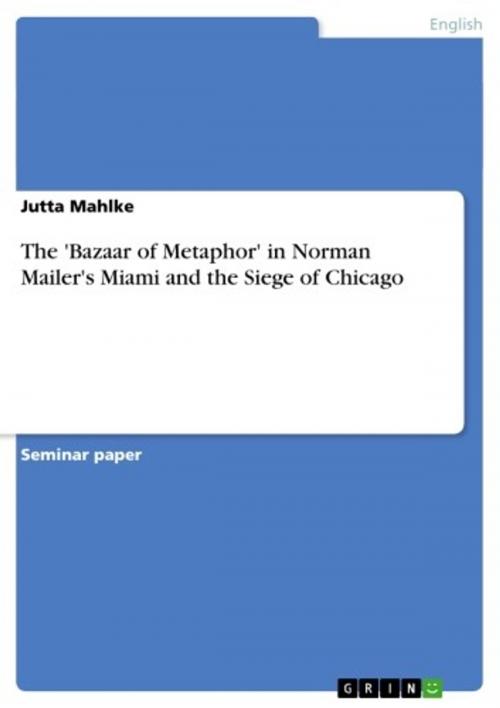The 'Bazaar of Metaphor' in Norman Mailer's Miami and the Siege of Chicago
Nonfiction, Entertainment, Drama, Anthologies| Author: | Jutta Mahlke | ISBN: | 9783638297806 |
| Publisher: | GRIN Publishing | Publication: | August 4, 2004 |
| Imprint: | GRIN Publishing | Language: | English |
| Author: | Jutta Mahlke |
| ISBN: | 9783638297806 |
| Publisher: | GRIN Publishing |
| Publication: | August 4, 2004 |
| Imprint: | GRIN Publishing |
| Language: | English |
Seminar paper from the year 2000 in the subject American Studies - Literature, grade: 2 (B), Ruhr-University of Bochum (English Seminar), course: The Greening of America: Fiction and Anti-fiction in the 1960s, language: English, abstract: Mailer, the novelist, sees himself as agent for change. His critics on the other hand assign to his works the brilliancy of reportage. The nonfiction novel exists in order not to change the American situation that makes possible so much literary aggression against it. Norman Mailer's Miami and The Siege of Chicago is an account of the 1968 Conventions in Miami (Republicans) and Chicago (Democrats). This 'classic work of interpretive political reportage'4,5 consists of two parts, the first 'Nixon in Miami' and the second 'The Siege of Chicago'. Mailer uses a device he developed to high craft: third-person story telling based on first-person participation.'His style and rhetorical devices stand out among other novelists. When Mailer describes the Republican convention in Miami using metaphorical language filled with disgust he risks to offend the audience: 'And the country roaring like the bull in its wounds, coughing like a sick lung in the smog [...].' His informal critical account is often directed against the audience. Even though it sounds like a paradox, with this style Mailer, the surrealistic critic and observer of American society, seems to attract many readers to his novels. The Republican Convention 1968 in Miami preceded the election of Nixon as 33rd American President, which was a close victory of 43,4% vs. Hubert Humphrey of the Democrats with a total of 42,7% votes. The Amphitheatre in Chicago, location of the Democratic Convention, had according to Mailer then the 'packed intimacy of a neighborhood fightclub'8 and 'the air of circus was also the air of slaughterhouse'. Chicago was also home to a Yippie Convention, which made the situation worse and was reason enough for the Democrats to discuss about another location. This paper will try to analyse the style and metaphors for political action in the novel. This will be done on the levels of setting, character, point of view, plot, and theme. It will be shown that the significance of the metaphors is not limited to providing mere background color. Rather, they are integrated on all levels of the novel and provide it with many opportunities to bring Mailer's intentions home to the reader, as the final subchapter will elaborate.
Seminar paper from the year 2000 in the subject American Studies - Literature, grade: 2 (B), Ruhr-University of Bochum (English Seminar), course: The Greening of America: Fiction and Anti-fiction in the 1960s, language: English, abstract: Mailer, the novelist, sees himself as agent for change. His critics on the other hand assign to his works the brilliancy of reportage. The nonfiction novel exists in order not to change the American situation that makes possible so much literary aggression against it. Norman Mailer's Miami and The Siege of Chicago is an account of the 1968 Conventions in Miami (Republicans) and Chicago (Democrats). This 'classic work of interpretive political reportage'4,5 consists of two parts, the first 'Nixon in Miami' and the second 'The Siege of Chicago'. Mailer uses a device he developed to high craft: third-person story telling based on first-person participation.'His style and rhetorical devices stand out among other novelists. When Mailer describes the Republican convention in Miami using metaphorical language filled with disgust he risks to offend the audience: 'And the country roaring like the bull in its wounds, coughing like a sick lung in the smog [...].' His informal critical account is often directed against the audience. Even though it sounds like a paradox, with this style Mailer, the surrealistic critic and observer of American society, seems to attract many readers to his novels. The Republican Convention 1968 in Miami preceded the election of Nixon as 33rd American President, which was a close victory of 43,4% vs. Hubert Humphrey of the Democrats with a total of 42,7% votes. The Amphitheatre in Chicago, location of the Democratic Convention, had according to Mailer then the 'packed intimacy of a neighborhood fightclub'8 and 'the air of circus was also the air of slaughterhouse'. Chicago was also home to a Yippie Convention, which made the situation worse and was reason enough for the Democrats to discuss about another location. This paper will try to analyse the style and metaphors for political action in the novel. This will be done on the levels of setting, character, point of view, plot, and theme. It will be shown that the significance of the metaphors is not limited to providing mere background color. Rather, they are integrated on all levels of the novel and provide it with many opportunities to bring Mailer's intentions home to the reader, as the final subchapter will elaborate.















